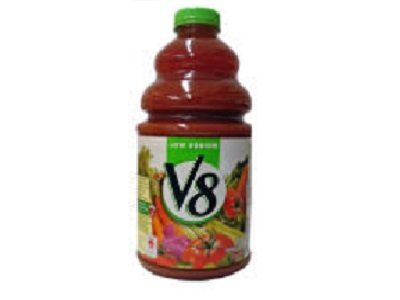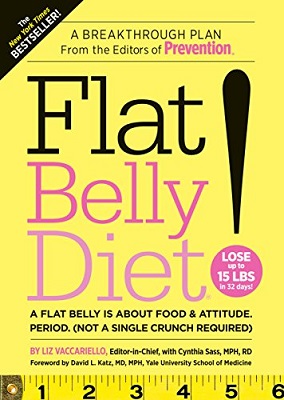
Review: V8 Diet
The V8 Diet is a type of eating plan that is based on drinking the brand’s vegetable juice as a component of an overall calorie reduced diet. This eating strategy hasn’t been laid out in a way that is entirely clear to many dieters.

The V8 Diet is a type of eating plan that is based on drinking the brand’s vegetable juice as a component of an overall calorie reduced diet. This eating strategy hasn’t been laid out in a way that is entirely clear to many dieters.

The Flat Belly Diet is an eating strategy designed to help people lose weight effectively. It was created by Prevention magazine editors. This diet promises to make weight loss fast and easy, especially when it comes to fat stored around the middle. This is supposed to occur in about one month.
The diet’s creators say that the Flat Belly Diet lets dieters change the way they eat to drop the pounds. In fact, exercise isn’t a requirement of this plan. That said, the creators of the diet do underscore that if you do exercise, it can help to boost results from the other efforts made throughout the month.
There are two phases to the Flat Belly Diet. The first is four days long and is meant to help combat bloating. It uses specific drinks and foods to help followers to overcome bloating. That way, the dieter won’t be carrying extra size that doesn’t need to be there and that isn’t even caused by body fat.
The second phase is a four-week eating plan that affords dieters a set number of calories. Women eat about 1,600 calories per day. Men follow a similar plan but with a higher number of daily calories allowed.
The Flat Belly Diet places the emphasis on eating foods high in monounsaturated fatty acids (MUFAs). Dieters must also eat lots of whole grains, fruits and veggies. Every meal must contain MUFAs. These foods include options such as seeds, nuts, avocados, olive oil and soybeans.
Despite the fact that the Flat Belly Diet was created by well respected people, the diet itself hasn’t been uniquely successful in research. Large clinical trials haven’t shown that using this technique is any more effective than any other calorie-restricted strategy.
Though a dieter might lose weight using these methods, they’re likely because of the calorie limitations and because it encourages healthy and nutritious eating, according to the Mayo Clinic’s analysis. This indicates that the additional methods recommended by the diet aren’t necessarily promoting additional weight loss. Instead, it’s the methods that are the same as other calorie restricted healthy diets that are helping these dieters to drop the pounds.
Though it advertises itself as a type of quick fix, it isn’t really all that different from following other traditional calorie-based diets with a focus on nutrition.

The Glycemic Index Diet isn’t a specific diet but a type of dieting based on the glycemic index. Some of the most common diets in this category include Nutrisystem, the Zone Diet, and Sugar Busters. The GI Diet is commonly recognized as the first form of dieting of this nature.
Glycemic Index Diet style dieting was created to assist people with diabetes to better keep their blood sugar levels under control. The idea is that when blood sugar is kept under control, it becomes easier for someone to lose excess weight as well. It is a form of low-carb dieting. It is somewhat complex in that it requires knowledge and use of the glycemic index.
The Glycemic Index Diet is based on the index that rates foods based on the impact the food has on blood sugar. Those higher on the index will cause the blood sugar to rise faster. Foods high up on the list include cookies, cakes, white bread and white potatoes.
When people eat foods lower on the glycemic index, it promotes a steadier blood sugar rise that won’t suddenly crash. These are often foods high in fiber, which also come with the benefit of maintaining a feeling of fullness. This way, there are fewer food cravings and hunger is satisfied for a longer period of time.
Adhering to the Glycemic Index Diet can help to prevent certain conditions such as heart disease and diabetes. That said, it isn’t typically consistently effective as a weight loss diet. Moreover, even when it does help a dieter to lose weight, it doesn’t do so any faster or easier than a low-carb, calorie controlled or overall healthy diet.
Studies showing that a Glycemic Index Diet leads to weight loss or causes more weight loss than a high-glycemic diet have been considered inconsistent at best.
Foods you can eat while following a Glycemic Index Diet depend on their score on the glycemic index. Examples of high G.I. foods are those with a score of 70 or higher. They include white bread, white bagels, white pasta, baked potatoes, crackers, beverages sweetened with sugar, white rice, and pretzels.
Medium G.I. foods have a score of 56 to 69. They include whole wheat pasta, grapes, raisins, corn, ice cream. Low G.I. foods have a score of 55 or lower. Examples of these foods include carrots, kidney beans, hummus, oatmeal, peas, peanuts, skim milk and the majority of fruits (with a few exceptions such as those listed in the other categories or watermelon).

The Biggest Loser Diet is a weight loss strategy based on the old NBC TV reality show, The Biggest Loser. Essentially, it requires you to follow a similar plan to the contestants on the series, only without the television cameras.
The show was highly controversial and is no longer on the air. Moreover, the majority of the contestants either regained some of the weight or all of it since the filming. Still, many people still want to try The Biggest Loser Diet in the hopes of dropping the pounds quickly.
Overall, the idea is that The Biggest Loser Diet will teach you to lose pounds like the show contestants did. It says you will lose weight, feel better, feel stronger and even reduce your blood pressure and cholesterol levels.
That said, you need to be ready to make a commitment to a pretty intense strategy. It is not an easy diet, and it does require you to go to certain extremes.
The Biggest Loser Diet recommends eating small meals frequently throughout the day. The majority of what you eat is made up of lean protein, soy, low-fat dairy, vegetables, fruits, whole grains, beans and nuts.
The eating strategy is based on The Biggest Loser Diet 4-3-2-1 Pyramid. This means four servings of fruits and veggies, three of lean protein, two of whole grains, and one amount of 200 calories for “extras”. You are also supposed to drink between six and eight glasses of water daily.
Overall, it is considered to be a medium difficulty level diet. It does require quite a lot of commitment. Most people need to make quite a lot of changes to their lifestyles, including both food and exercise. However, most of what you must do isn’t technically that difficult. The most challenging part is actually sticking to it because of the amount of change and effort required.
The foods you’re required to eat are widely available, which means you won’t need to shop at new specialty stores. You will need to continually read food labels and exercise a great deal. There are cookbooks to follow to know how to prepare the food.
While The Biggest Loser Diet can be done and is within the reach of most people for a while, the main complaint against it has to do with sticking with it. Most people are unwilling to keep up the changes required for this diet over the long term.